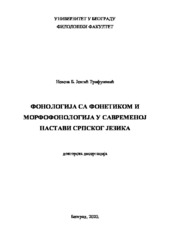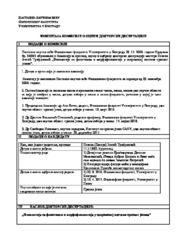Приказ основних података о дисертацији
Фонологија са фонетиком и морфофонологија у савременој настави српског језика
Phonetics, phonology and morphophonology in contemporary Serbian language teaching Фонология с фонетикой и морфофонология в современном преподавании сербского языка
| dc.contributor.advisor | Brborić, Veljko | |
| dc.contributor.other | Batas, Ana | |
| dc.contributor.other | Veljković Stanković, Dragana | |
| dc.contributor.other | Novokmet, Slobodan | |
| dc.creator | Jevtić Trifunović, Nevena B. | |
| dc.date.accessioned | 2022-02-23T14:04:23Z | |
| dc.date.available | 2022-02-23T14:04:23Z | |
| dc.date.issued | 2021-04-16 | |
| dc.identifier.uri | https://uvidok.rcub.bg.ac.rs/bitstream/handle/123456789/4180/Referat.pdf | |
| dc.identifier.uri | http://eteze.bg.ac.rs/application/showtheses?thesesId=8497 | |
| dc.identifier.uri | https://fedorabg.bg.ac.rs/fedora/get/o:25024/bdef:Content/download | |
| dc.identifier.uri | http://vbs.rs/scripts/cobiss?command=DISPLAY&base=70036&RID=53483273 | |
| dc.identifier.uri | https://nardus.mpn.gov.rs/handle/123456789/18935 | |
| dc.description.abstract | Предмет рада јесте свеобухватно сагледавање наставе српског језика из области фонетике (са фонологијом) и морфофонологије, и то на основу опсежне анализе глобалних планова и програма, акредитованих наставних средстава, и евалуације ученичког и студентског теоријског и практичног знања из фокусираних области. Стога је основни циљ рада Фонологија са фонетиком и морфофонологија у савременој настави српског језика да се пружи одређени допринос у побољшању квалитета анализираних наставних докумената и средстава, као и у унапређивању и популаризовању наставе фонетике и морфофонологије српског језика. Како би се добила јасна слика и омогућили прецизни и функционални закључци, издвојеним лингвистичким областима се у овом раду приступило на два начина: 1) кроз испитивање њиховог присуства у актуелним наставним плановима и програмима, академским силабусима, као и акредитованој уџбеничкој, приручничкој и граматичкој литератури; 2) кроз испитивање степена усвојености ученичког и студентског теоријског и практичног знања из фонетике и морфофонологије српског језика. Према подацима добијеним методом теоријске анализе, утврђено је да основношколски и средњошколски наставни планови не предлажу оквиран фонд часова који је неопходан за реализацију наставе фонетике и морфофонологије, а да наставни програми не прокламују прецизно граматичке садржаје које ученици треба да савладају (категорије у којима се одређена гласовна алтернација реализује, односно, категорије у којима се од ње одступа и сл.). Анализом садржаја акредитованих основношколских и средњошколских уџбеника и приручника, који се односе на фонетику (са фонологијом) и морфофонологију, дошло се до закључка да сви они, упркос различитој апаратури презентације и структурализације, представљају фундаменталне особености неопходне за успешно савладавање гласовног система и гласовних алтернација српског језика. Ништа није другачије ни у репрезентативним педагошким и референцијалним граматикама. У складу са групом корисника којима су намењене, све испитиване граматике и приручници омогућавају солидан увид у теоријске поставке фонетике (са фонологијом) и морфофонологије, и на тај начин повољно утичу на њихово продуктивно савладавање. Евалуација ученичког и студентског знања из издвојених области спроведена је уз помоћ истраживачке технике – тестирања. Узорком је обухваћено укупно 693 испитаника различитог узраста (основна школа 223, средња школа 240 и факултет 230). Показани резултати нивоа знања ученика и студената из области фонетике и морфофонологије потврдили су да истраживане популације владају садржајима који се тичу познавања гласовног система српског језика; затим, да виши разреди основних и средњих школа не доносе значајнији напредак у овладавању фонолошки, односно, морфолошки условљеним гласовним алтернацијама, као и да је континуитет у учењу, који подразумева проширивање и утврђивање градива из нижег у виши ниво образовања, изостао и приликом провере разлике у знањима ученика завршног разреда средње школе и студената прве године факултета о морфолошки условљеним гласовним алтернацијама. Такође, потврђено је да факултетски бруцоши поседују већи степен знања о фонолошки условљеним алтернацијама у односу на своје колеге из струковне академије, као и да апсолвенти оба истраживана факултета остварују солидне и процентуално скоро идентичне резултате у задацима са морфолошки условљеним гласовним алтернацијама. Пронађена је и статистички значајна разлика у постигнућима испитиваних популација када су посреди задаци у којима је требало препознати једну или више гласовних алтернација, али и приликом провере ученичке/студентске способности за решавање питања отвореног/затвореног типа. Наиме, сви узорковани ученици и студенти су остварили видно боље резултате на примерима који су илустровали једну гласовну алтернацију, у односу на оне у којима се могло препознати више морфонолошких процеса, и са већом успешношћу решавали једноставније него комплексне задатке. Након евалуације постојећег стања у настави граматике, у закључном делу рада креиране су импликације које имају за циљ да, кроз иновативне моделе учења, сазнавања, увежбавања и систематизовања знања, наставу фонетике (са фонологијом) и морфофонологије осавремене и подигну на виши ниво. | sr |
| dc.description.abstract | This thesis presents the investigation of the status of phonetics (with phonology) and morphophonology in contemporary Serbian language teaching, based on a thorough investigation of the teaching curricula and syllabuses for this school subject and of the accredited teaching materials, as well as on the evaluation of the students’ theoretical and applied knowledge in the investigated areas. Therefore, the main aim of this thesis was to contribute to the improvement of the teaching documents and materials, as well as to the promotion of the status of phonetics and morphophonology in Serbian language teaching. In order to obtain an accurate evaluation of the state of the matter in the investigated linguistic domains, and to arrive at more accurate and functional conclusions, the studied areas were observed from two perspectives: 1) by investigating the degree to which these linguistic areas are represented in the teaching curricula and syllabuses, as well in the accredited materials and literature – textbooks, workbooks and grammars; 2) by investigating the degree of theoretical and applied knowledge acquired by primaryschool, secondary-school and tertiary-level students in the areas of Serbian phonetics and morphophonology. The data obtained by the method of theoretical analysis showed that primary- and secondary-school curricula and subject syllabuses do not define the required number of teaching hours necessary for covering the areas of phonetics and morphophonology, and that the subject syllabuses do not specify in enough detail the grammar areas that the students are expected to master (the categories in which a certain phonological alternation is realised, that is, the categories in which it is not realised, etc.). The analysis of the accredited primary- and secondary-school textbooks and workbooks and their content relevant for phonetics (with phonology) and morphophonology revealed that all of them, apart from their differences in terms of presentation structure and methodology, do present the fundamentals necessary for a successful acquisition of the phonemic system and phonological alternations in the Serbian language. The analysis of the representative pedagogical and reference grammar books revealed the same picture. Taking into consideration the targeted age groups of their users, all the investigated grammar books and workbooks do offer a reasonable insight into the theoretical concepts of phonetics (with phonology) and morphophonology, and thus aid students’ acquisition and productive application. The evaluation of students’ knowledge in the investigated linguistic areas was performed by means of the research technique of testing. The population in this part of the research study comprised 693 participants classified into three age and level groups: 223 primary-school students, 240 secondary-school students, and 230 tertiary-level students. The results of the investigation of students’ knowledge in the areas of phonetics and morphophonlogy showed that the investigated populations exhibited a solid understanding of the Serbian sound system; however, the results also showed that students of higher grades of primary and secondary school did not show significantly higher levels of mastery with respect to the phonologically or morphologically conditioned sound alternations; additionally, there was a certain lack of continuity in terms of knowledge consolidation and broadening between lower and higher levels of education, observed in the comparison of test results between the high-school senior students and university-level freshmen, with respect to the morphologically conditioned sound alternations. Furthermore, the findings indicated that, among tertiary-level students, the university (faculty) freshmen showed a higher level of knowledge about the phonologically conditioned alternations compared to the freshmen of the vocational academy (college), but that senior students (graduates) of both tertiary-level institutions exhibited almost identical results in the tasks involving morphologically conditioned sound alternations. Statistically significant differences were found between the test results in the tasks that required the participants to recognize one or more sound alternations; similarly, statistically significant differences were observed between the students’ results in the closed test tasks and openended questions. Namely, all the students, in all the age- and level- groups, showed much better results in those test items that required them to recognize one sound alternation, compared to the tasks that involved several morphophonological processes; also, all the participants performed much more successfully in simpler than in more complex test tasks. Following the evaluation of the state of affairs in Serbian grammar teaching, the final chapter of this thesis offers pedagogical implications and includes suggestions regarding the ways in which innovative learning models, discovery, practice and knowledge systematization could be used to improve and enhance the teaching of phonetics (with phonology) and morphophonology in contemporary Serbian language teaching. | en |
| dc.format | application/pdf | |
| dc.language | sr | |
| dc.publisher | Универзитет у Београду, Филолошки факултет | sr |
| dc.rights | openAccess | en |
| dc.rights.uri | https://creativecommons.org/licenses/by-nc-nd/4.0/ | |
| dc.source | Универзитет у Београду | sr |
| dc.subject | српски језик | sr |
| dc.subject | Serbian language | en |
| dc.subject | phonetics | en |
| dc.subject | phonology | en |
| dc.subject | morphophonology | en |
| dc.subject | teaching curricula and syllabuses | en |
| dc.subject | textbooks | en |
| dc.subject | Serbian language teaching methodology | en |
| dc.subject | фонетика | sr |
| dc.subject | фонологија | sr |
| dc.subject | морфофонологија | sr |
| dc.subject | наставни план и програм | sr |
| dc.subject | уџбеник | sr |
| dc.subject | методика наставе српског језика | sr |
| dc.title | Фонологија са фонетиком и морфофонологија у савременој настави српског језика | sr |
| dc.title.alternative | Phonetics, phonology and morphophonology in contemporary Serbian language teaching Фонология с фонетикой и морфофонология в современном преподавании сербского языка | en |
| dc.type | doctoralThesis | |
| dc.rights.license | BY-NC-ND | |
| dcterms.abstract | Брборић, Вељко; Вељковић Станковић, Драгана; Новокмет, Слободан; Батас, Aна; Јевтић Трифуновић, Невена Б.; Fonologija sa fonetikom i morfofonologija u savremenoj nastavi srpskog jezika; | |
| dc.identifier.fulltext | http://nardus.mpn.gov.rs/bitstream/id/142175/Izvestaj_Komisije_12081.pdf | |
| dc.identifier.fulltext | http://nardus.mpn.gov.rs/bitstream/id/142174/Disertacija_12081.pdf | |
| dc.identifier.rcub | https://hdl.handle.net/21.15107/rcub_nardus_18935 |



